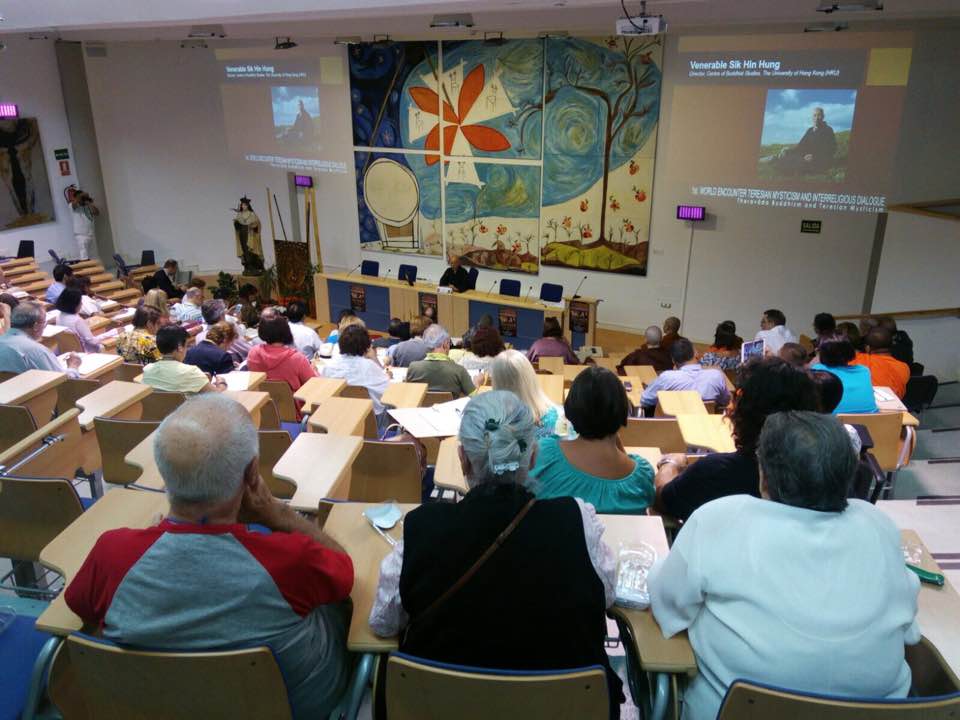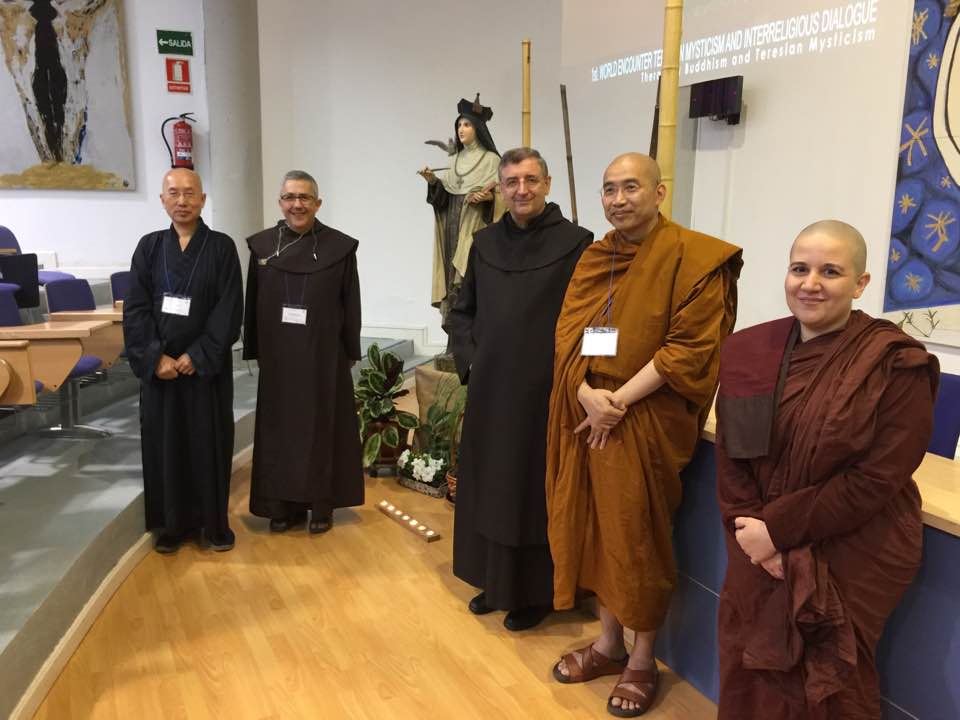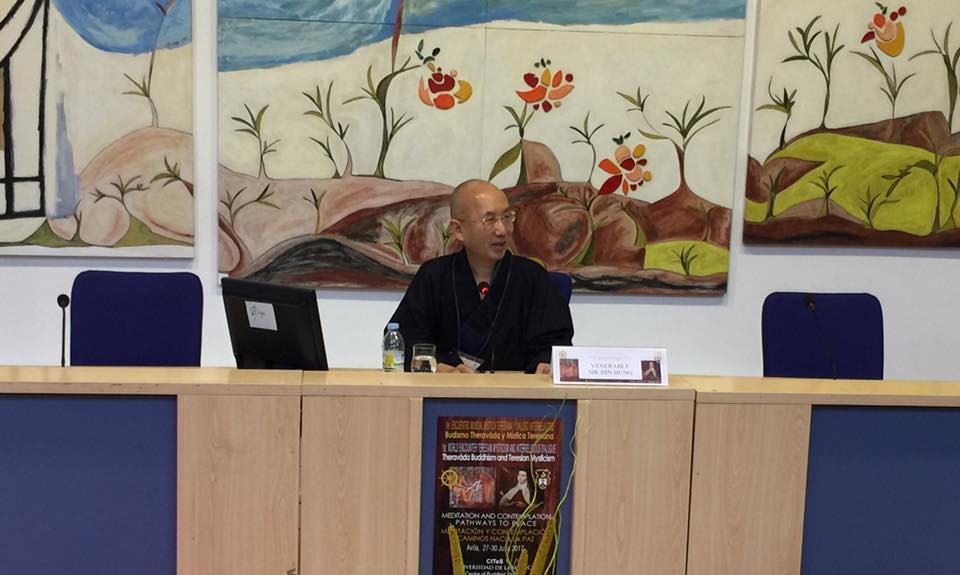A speech given by Ven. Hin Hung, director of the Centre of Buddhist Studies at The University of Hong Kong, on 27 July 2017 at The University of Mysticism in Avila, Spain.
Our world is rapidly changing. With the advances in science and technology, modern means of communication and transportation bring us closer together, but, at the same time, dividing and distancing people and cultures in a deeper level. Cultural conflicts and competition lead to hatred and violence, which unsettles world peace. The pervasiveness of materialism, consumerism, and individualism creates greed, suffering and despair, inciting doubt in the meaning of life in the minds of many. Issues like ecological degradation are global and cross-regional affecting all of us. They cannot be ignored and demand our immediate attention and urgent response.
Engaging in genuine interreligious dialogue is a constructive response to these challenges. Many difficulties that we face today arise from ignorance, fear, and misconceptions. Interfaith dialogue is indispensable because, without peace among religious communities, peace in the world would not be possible. Through dialogue, understanding and acceptance of each other’s traditions and values would be nourished; intolerance and hatred would be reduced. By being broad-minded, one realizes that others are likewise pursuing their spiritual paths, and, very often, share the universal ideals of love and compassion. Last but not least, interreligious dialogue would set an example of how different communities can live in harmony in a world that is continuously being “flattened out.”
In its long history, Buddhism has always coexisted with other religious traditions. Looking back at its origin, Buddhism coexisted in India with Brahmanism and Jainism. It interacted with native religions like Daoism and Confucianism in China; and mingled with the indigenous religion Shinto in Japan. In Sri Lanka, Theravada Buddhism has cohabited for centuries with Christianity. Buddhism comprises of many traditions and with approaches towards other traditions that varies from exclusivism to inclusivism, and recently pluralism. Nonetheless, the prevalent attitude towards other traditions can be characterized as one of mutual engagement, acceptance and understanding.
The Buddha encouraged communication as the way to solve religious differences. In the canonical scriptures, the Buddha demonstrated this attitude by having cordial and peaceful conversation with his non-Buddhist contemporaries. In such religious encounters, the Buddha is always portrayed as an objective, knowledgeable, and insightful observer, always courteous and respectful. He can adapt to people from all walks of life, skillfully and appropriately guide them on the path of ending suffering.
The Buddha’s appreciation of religious freedom and diversity goes hand in hand with his recognition of religious differences. The Buddha was not uncritical of other traditions, nor did he consider that all paths converge to the same destination. But, Buddhism is unique in its ultimate goal that is to attain full enlightenment, resulting in a full and complete end of suffering. Thus, we should not subsume one religion into the framework of another automatically because that would be meaningless and unnecessary.

Nonetheless the Buddha recognized that truth, and value could be found in other traditions as long as these traditions contribute to the elimination of suffering. In the Udumbarika-sihanada Sutta (DN 25), the Buddha acknowledges the merits of the creeds of other religions declaring: “let those points of your doctrines which are good […] remain so still” and encourages the wandering ascetic Nigrodha not to abandon his faith saying “Let him who is your teacher remain your teacher.” In the Upali Sutta (MN 56) the Buddha advises the Jain follower Upali not to relinquish support for Jainism. Moreover, in the Mahasihanada Sutta (DN 8) we meet the Buddha in dialogue with spiritual teachers of other traditions putting aside topics on which no agreement is possible and continuing the friendly dialogue on those topics on which there is a common ground. In the canonical scriptures, apart from the Buddha, the enlightened one, there are also solitary Buddhas (pratyekabuddha), which implies that enlightenment can be attained independently of the Buddha’s teaching.
Many Buddhists recognize that goodness and spiritual growth can be found in other traditions and appreciate their uniqueness. Buddhist masters of today like the Dalai Lama and Thich Nhat Hanh, for example, not only respect but also are great admirers of Christianity and have advocated interreligious dialogue. In the case of St. Teresa, because of her virtues of love, compassion, determination and humility, many Buddhists admire her and hold her in very high regard.
In its interaction with other religious traditions, Buddhism has discovered new aspects of itself, as a result, allowing it to adapt and grow. It is only fair to say that the Christian tradition has also been a source of inspiration to Buddhists in areas relating to education, social justice, and social services. On the other hand, we also know that many Christians have been interested in Buddhist meditation practices.
As our two religions will be engaging in continuous dialogue in the coming days, please allow me to take a few minutes to give a brief introduction to the Buddhist religion and the role of meditation in Buddhism. I will first present how Early Buddhism understands these topics and follow with how Mahayana Buddhism understands them. As opposed to Early Buddhism, which began with Shakyamuni Buddha around 2600 years ago, Mahayana Buddhism came into existence around 200 BCE. The teaching of Theravada Buddhism, the tradition that will be representing in this conference, is very close to Early Buddhism. Both Chinese Buddhism and Tibetan Buddhism are branches of Mahayana Buddhism.

The objective of Buddhism is to solve the lingering problem of human suffering. To achieve this objective, the Buddha taught the Four Noble Truths which is the foundation of all Buddhist teachings. Truth here implies reality. According to the Buddha, the Four Noble Truths are four realities that a person with a sound mind would see and recognize. They are:
(1) The Noble Truth of Suffering. Suffering is a reality in life. We should recognize this reality and aspire to eliminate suffering.
(2) The cause of suffering. There are causes to suffering, and they are craving and ignorance. One should aspire to eliminate these causes of suffering.
(3) The cessation of suffering. The cessation of suffering is possible. Through the elimination of craving and ignorance, suffering will cease. One should attain this liberation and be free from the causes of suffering and suffering.
(4) The path to attain the cessation of suffering. There is a Noble Path that can leads to the cessation of suffering, namely:
- Right View
- Right Thought
- Right Speech
- Right Action
- Right Livelihood
- Right Effort
- Right Mindfulness
- Right Concentration
These eight components of the Noble Path should not be viewed as independent of each other because they integrate and interact in ways that allow the impact of the whole path to become more powerful than the sum of its parts. Of course, the most important of all is “right view,” which would legitimatize and validate the “right” in the other seven paths.
The role of meditation in Buddhism can best be understood through this Noble Path of ending suffering. Generally speaking, Buddhist meditative practice would involve the practice of right mindfulness and right concentration under the guidance of right view. Without right view, mindfulness and concentration would not be “right.”
 The Buddha pointed out that the root of suffering is craving (tanha) which is instigated by ignorance and the attachment to the concepts of “I”, “self”, and “mine.” To break this shackle of ignorance and craving, a person must practice concentration (samadhi), a core component of Buddhist meditation. There are two parts to samadhi, namely the practices of calm abiding (shamatha) and the practice of wisdom (vipashyana). It is only through the successful integration of the practices of calm abiding and wisdom that a person can see clearly that both the body and mind are impermanent and suffering, thereby, relinquishing the attachment to the concept of self. When the concept of self is relinquished, ignorance and craving would cease, and, hence, the cessation of suffering. Further details on the Four Noble Truths will be elaborated by the speakers in the coming days.
The Buddha pointed out that the root of suffering is craving (tanha) which is instigated by ignorance and the attachment to the concepts of “I”, “self”, and “mine.” To break this shackle of ignorance and craving, a person must practice concentration (samadhi), a core component of Buddhist meditation. There are two parts to samadhi, namely the practices of calm abiding (shamatha) and the practice of wisdom (vipashyana). It is only through the successful integration of the practices of calm abiding and wisdom that a person can see clearly that both the body and mind are impermanent and suffering, thereby, relinquishing the attachment to the concept of self. When the concept of self is relinquished, ignorance and craving would cease, and, hence, the cessation of suffering. Further details on the Four Noble Truths will be elaborated by the speakers in the coming days.
In contrast to the teachings of Early Buddhism as explained above, Mahayana Buddhism places emphasis on compassion and eliminating suffering for all sentient beings. It is on the development of the commitment to save all sentient beings and attaining the ultimate enlightenment that an ordinary person becomes a bodhisattva, a practitioner of the Mahayana path. With this commitment, bodhicitta, the bodhisattva will take up the practice of the Six Perfections (paramita), namely, generosity, discipline, patience, diligence, concentration and wisdom.
Similar to practices in Early Buddhism, concentration is also a core component in the practice of Mahayana Buddhism. Although the objects of concentration maybe different between Early Buddhism and Mahayana Buddhism, its role in supporting and nourishing the development of wisdom is identical. Moreover, according to Mahayana Buddhism, its understanding of the emptiness nature of phenomena is profound and comprehensive, therefore, the prajna wisdom that arises from this understanding enables a bodhisattva to be more skillful and persistence in helping sentient beings.
Another major difference between Early Buddhism and Mahayana Buddhism is that Mahayana Buddhism believes in the sanctification and supernatural power of the Buddhas and bodhisattvas. Therefore, apart from using mind and body as the meditation objects, Mahayana Buddhists also take Buddhas, bodhisattvas and mantra as their meditation objects, believing that these holy objects would have special blessing.
In a recent neuro-scientific experiment that we did at the Centre of Buddhist Studies of the University of Hong Kong, we were able to identify that repetitive religious chanting could modulates the late-stage brain response to fear- and stress-provoking pictures. We used event-related potentials (ERPs) to explore the effects of chanting the name of a Buddha (Amitābha) on the brain’s response to viewing negative pictures that were fear- and stress- provoking. We recorded and analyzed electroencephalography (EEG) data from 21 Buddhists with chanting experience as they viewed negative and neutral pictures.
Participants were instructed to chant the name of Amitabha or that of a neutral figure that they are familiar with silently to himself or herself or simply remain silent (no-chanting condition) during picture viewing.
Results showed that viewing negative pictures (vs. neutral pictures) increased the amplitude of the N1 component (a measure of attentional processes) in all the chanting conditions. The amplitude of late positive potential (LPP) (a measure of information recollection) also increased when the negative pictures were viewed under the no-chanting and the reciting the name of the neutral figure condition.
However, increased LPP was not observed when chanting Amitabha. It is possible that the chanting of Amitabha might have helped the participants to develop a religious schema and neutralized the effect of the negative stimuli.
These findings echo similar research findings on Christian religious practices and brain responses to negative stimuli. Hence, prayer/religious practices may have cross-cultural universality in emotion regulation.

These coming days of interfaith encounter offer us many opportunities to learn from each other. We can advance our understanding of different spiritual beliefs and practices, on each of our own terms and without subsuming one under the other. However, for sustainable peace and harmony in the world, tolerance alone will not be enough, and not even with just mutual understanding. We must aim to move beyond both, to achieve genuine friendship and fraternity.
One of the functions of interfaith dialogue is to explore the differences and affinities among religions. Differences are important, for we need to know how we differ. However, although we walk on different paths, there is a long stretch of common ground on which we walk together. On this common ground, there are intriguing commonalities between the Theravada and Carmelite paths which deserve attention and explanation. This Encounter will enable us to see many of the things that are important to both religions. So, both are probably dealing with the same or similar issues but only viewed from different angles.
Truth and goodness are not tradition-specific, and any tradition can be perfected in their own way. Being rooted in one’s own faith, nonetheless, we can recognize what is good in other religions. We surely can learn from each other but without ever losing our own identity. Many Buddhists know of the Carmelites’ rich contemplative tradition, and deeply appreciate the work of St. Teresa of Avila. It will be beneficial for Buddhists to learn from the experiences and insight from the Carmelites’ contemplative tradition.
Through mutual involvement, we will be able to cooperate. Our two traditions need not have to agree on the same ultimate spiritual ends to work together for the common good. There are many areas where we can connect, in which, like good neighbours, we can cooperate to alleviate suffering in the world, foster brotherly love and compassion. The aim is to promote a more peaceful world through the promotion of spiritual practices and building of harmonious relationships. This will be for the benefit of all.
The theme of our interfaith encounter is “Meditation and Contemplation Pathways to Peace.” True peace is not only the absence of explicit conflict; it means harmony and the absence of hatred and suffering. Everything is interconnected to everything else and there can be no peace in the world without peace inside the person. In this light, both our religious traditions recognize that meditation and contemplation are the most effective tools to deal with hatred, greed, selfishness and ignorance, the root of suffering and violence. Therefore, to promote meditation and contemplative practice is to promote inner peace and peace in the world.

